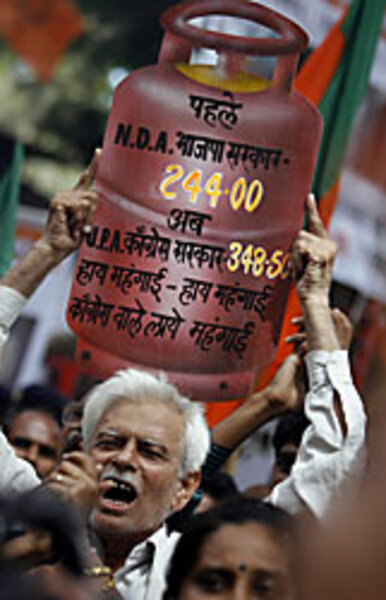Facing inflation, Asia gets more aggressive
| Bangkok, Thailand
Across Asia, the bugbear of inflation is back, and it's not just policy wonks who are feeling the strain. Faced with rippling social unrest over soaring prices for fuel and food, governments are struggling to cushion the blow, while keeping economic growth on track.
With inflation rates at multiple-year highs in Thailand, Vietnam, South Korea, and Indonesia, policymakers are reluctantly raising interest rates in a bid to keep a lid on rising prices. At the same time, Asian governments are having to slash fuel subsidies to stop their own budget blowouts, all the while keeping a wary eye on the political backlash.
Last week, Malaysia raised pump prices by 41 percent for gasoline and 67 percent for diesel, to the dismay of consumers accustomed to cheap fuel, and to the delight of an emboldened opposition that has begun planning nationwide anti-inflation rallies. Reaction was swifter in India, where protests broke out in West Bengal after double-digit fuel price rises that, analysts say, could dent the popularity of the ruling Congress Party.
As global oil prices stay high, the pressure on Asian central banks to tackle inflation is growing. The dilemma is how to raise interest rates without slowing the growth that underpins the popularity of many governments in the region. But there's little doubt that global price trends are forcing policymakers to act now.
"We're facing inflationary pressures not only here in Asia but around the world. The impact of higher global energy and food prices is driving the inflation numbers," says David Cohen, director of Asian economic forecasting at Action Economics in Singapore, who expects that India will raise interest rates, following Indonesia, Vietnam, and the Philippines.
On June 9, US Federal Reserve chairman Ben Bernanke also raised concerns over oil-led inflationary pressures in a speech that some observers took as signaling future rate increases. The Fed has been cutting rates to try to head off a recession, something keenly watched by exporters in Asia.
Six months ago, Asian policymakers were bracing for economic pain from slowing exports to the US, says James McCormack, head of Asia-Pacific sovereign ratings at Fitch Ratings in Hong Kong. At the same time, they figured that weaker demand in the US and other major economies would crimp global commodity prices, trimming their own import bills. Instead, Asia is confronting soaring prices for oil and other essentials, forcing policymakers into an inflation-fighting corner.
"We may be starting to get on top of the issue, but it's a problem and we expect more action from policymakers," says Mr. McCormack, who recently downgraded his rating on Vietnam, where inflation is more than 25 percent.
Slower growth in Asia, which depends on imported fuel, should eventually feed into lower global commodity prices, though economists caution that oil has defied such forecasts before. One key item in inflation is rice, which has retreated from record highs earlier this year. But aid agencies continue to warn that food costs are cutting into budgets for humanitarian operations.
Rising food prices have been roiling Vietnam, whose Communist rulers have transformed their economy into a low-cost manufacturing hub. This success in luring foreign investment has led to rapid overheating at a time of global inflation, resulting in a squeeze on workers, whose incomes haven't kept pace with food prices that are up nearly 70 percent from a year ago.
A wave of strikes
Factories in Vietnam have seen a wave of strikes over low wages, and some workers have quit jobs and returned to villages where living costs are lower, says Jonathan Pincus, chief economist for the United Nations in Hanoi. As authorities tighten monetary policy and tackle high prices, the result may be a slowdown. "There is a need to trade off some growth to bring down inflation this year and I think that the government recognizes this," he says.
To defuse social pressures, Asian governments have tried to ease the burden of rising prices with targeted handouts. These are more effective than subsidies on pump prices, provided they are properly administered, say economists. Thai Finance Minister Surapong Suebwonglee said Monday that, starting next month, he would provide food coupons to low-income families after inflation hit a near-decade high of 7.6 percent in May.
Some governments are also promising to curb discretionary spending. Malaysian Prime Minister Abdullah Badawi, who has been under pressure to quit since an election setback in March, has tried to dampen anger over last week's fuel hikes by vowing to cut perks for government ministers and reducing their overseas travel.
Contrast with 1997 financial crisis
While some observers in Asia have drawn parallels between the inflation spike and the 1997-98 financial crisis, the differences are telling.
Ten years ago, overheated economies ran budget deficits that led to a run on pegged currencies and a collapse in confidence. Today, many Asian governments are running capital surpluses and sitting on huge foreign reserves while their currencies have gained against a weak dollar.
This is one reason why policymakers in Thailand are wary of raising rates and attracting capital inflows that push up the currency, says Chris Bruton, managing director of Dataconsult, an independent consultancy in Bangkok. But the risk of social unrest over food prices weighs heavily in Thailand, where antigovernment protests are on the rise. "If you take the political equation into consideration, you have to fight inflation first," he says.
Standing at an outdoor food market, Pranee Malhotra can see the impact for herself. A few months ago, her daily spending on vegetables to feed her family of four came to some $2. Today, it's over $3. "Everything is going up. Oil and rice are going up. It's affecting all of us, especially poor people," she says, before dropping a note into the begging bowl of a Buddhist nun.





